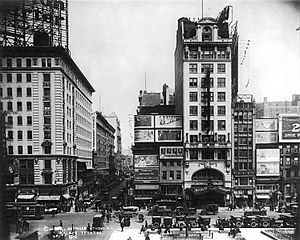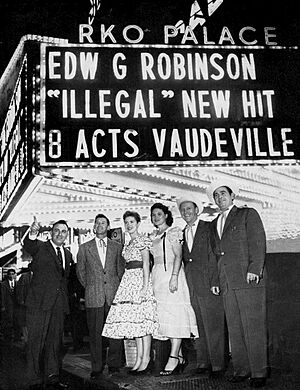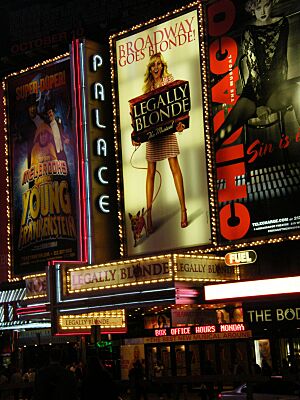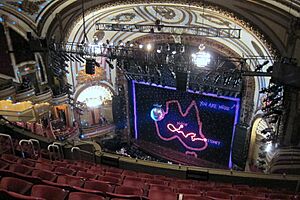Palace Theatre (New York City) facts for kids
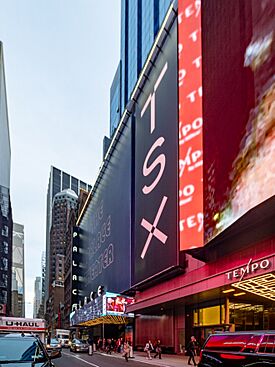
Palace Theatre entrance within TSX Broadway, 2024
|
|
| Address | 1564 Broadway Manhattan, New York United States |
|---|---|
| Coordinates | 40°45′32″N 73°59′05″W / 40.758842°N 73.984728°W |
| Owner | Nederlander Organization and Stewart F. Lane |
| Operator | Nederlander Organization |
| Type | Broadway |
| Capacity | 1,648 |
| Construction | |
| Opened | March 24, 1913 (vaudeville) January 29, 1966 (Broadway theater) |
| Rebuilt | 1987–1991, 2018–2024 |
| Years active | 1913–1932 (vaudeville) 1932–1965 (movie palace) 1966–present (Broadway) |
| Architect | Kirchhoff & Rose |
| Designated | July 14, 1987 |
| Reference no. | 1367 |
| Designated entity | Auditorium interior |
The Palace Theatre is a famous Broadway theater located at 1564 Broadway in New York City. It sits at the northern end of Times Square in the Midtown Manhattan area. Designed by architects Kirchhoff & Rose, the theater first opened its doors in 1913.
When it first opened, the Palace Theatre was a very important place for vaudeville performers. Vaudeville was a popular type of entertainment with many different acts, like singers, dancers, comedians, and acrobats. The Palace was seen as the main theater for vaudeville shows by Benjamin Franklin Keith and Edward Franklin Albee II's company until about 1929.
The theater has 1,648 seats spread across three levels. Its main performance area, called the auditorium, is a special New York City designated landmark. This auditorium is known for its beautiful plasterwork, special seating areas called boxes, and two balcony levels that slope down towards the stage.
Over the years, the Palace Theatre changed its purpose. After its vaudeville days, it became a movie palace in the 1930s, showing films. In 1965, the Nederlander Organization bought the theater and reopened it as a Broadway theater the next year. The building has gone through big changes, including major renovations from 1987 to 1991 and again from 2018 to 2024. As part of a huge project called TSX Broadway, the entire theater was even lifted 30 feet higher in 2022! The latest renovation was finished in May 2024.
Contents
The Palace Theatre's Home
The Palace Theatre is located at 1568 Broadway, right at the corner of Seventh Avenue and 47th Street. This area is part of the Theater District in Midtown Manhattan, New York City. It faces Duffy Square, which is the northern part of Times Square.
The theater was designed by architects Kirchhoff & Rose and finished in 1913. A vaudeville businessman named Martin Beck paid for its construction. The Palace Theatre has been part of three different buildings over its history. While the inside of the theater still has its original 1913 design, the first building was partly taken down in 1988. The theater then became part of the DoubleTree Suites Times Square Hotel, which was built between 1990 and 1991. Later, the DoubleTree Hotel was also taken down in 2019 to make way for the new TSX Broadway building.
Original Building Design
The first Palace Theatre building had two main parts: an office section facing Times Square and the theater section on 47th Street, which held the main performance hall. The office part was 11 or 12 stories tall and served as the main entrance to the theater. This entrance was grand, with fancy marble and special elevators.
Inside the theater, the design had a French style. The auditorium originally had 1,820 seats, with two balcony levels and 20 special boxes. It was decorated in colors of ivory and bronze. There were also many dressing rooms for the performers.
DoubleTree Suites Era
Between 1987 and 1991, an Embassy Suites hotel (which later became a DoubleTree Suites) was built on the site. This hotel replaced the old office wing on Broadway. The hotel was 43 stories tall and had 460 suites. The theater's front was mostly hidden behind huge billboards, as required by the rules for buildings in Times Square.
The hotel was built around and above the theater's original auditorium and stage area. The theater's lobby, the hotel's entrance, and some shops were on the ground floor. The theater's entrance was in about the same spot as before, and parts of the old lobby were kept.
TSX Broadway Development
In the late 2010s and early 2020s, the DoubleTree/Palace site was redeveloped as part of a huge project called TSX Broadway. This new building includes a 669-room hotel and was built around, above, and even below the Palace Theatre's auditorium.
A major part of this project was raising the entire auditorium by about 30 feet! This was done to create new retail space on the ground floor and even three levels underground. The auditorium now rests on strong columns that go deep into the ground.
As part of this project, the theater's main entrance was moved to 47th Street. This new entrance has escalators that take people up to a new lobby on the orchestra level, right next to the raised auditorium. The theater's overall size also doubled, from 40,000 to 80,000 square feet.
Inside the Auditorium
The auditorium is the only part of the original theater that is still standing, and it is a protected city landmark. It's built as a separate structure, so it's not directly connected to the buildings around it. The auditorium has special boxes, two balconies above the main floor (called the orchestra level), and a large stage with a big arch called a proscenium.
The auditorium's design was described as "Baroque with Beaux-Arts influences." Many of the original beautiful decorations that were removed over the years were brought back in the 2020s using old photos and plaster molds.
Seating Areas
As of 2024, the Palace Theatre has 1,648 seats. Before it closed for renovation in 2018, it had 1,743 seats. The orchestra level has a floor that slopes down towards the stage, like a ramp. Both balcony levels are curved and extend out over the orchestra, also sloping down towards the stage.
There are walkways on all three levels, and staircases connect them. One of these staircases was even nicknamed the "Judy Garland staircase" because the famous actress Judy Garland sometimes used it for surprise entrances! There is also an elevator that connects all three seating levels.
The orchestra level has special boxes on both sides. These boxes were changed a lot in a 1965 renovation. There are also more boxes on the sides of both balcony levels.
Other Design Features
The auditorium has a wide, curved ceiling that is divided into decorative panels with scrolls and floral designs. In the center of the ceiling, there is a dome with more decorations and a large, old-ivory bronze chandelier that is 14 feet wide.
The arch around the stage, the proscenium arch, is 44 feet wide and has many detailed moldings. Above the stage, there is a circular panel with a picture of a lyre, which is a musical instrument. In front of the stage, there is an orchestra pit where musicians play. The stage and orchestra pit both have special lifts that can move them up and down.
History of the Palace Theatre
The Palace Theatre was built by Martin Beck, who ran a big vaudeville company called the Orpheum Circuit. In the early 1900s, his company and the Keith–Albee circuit (run by Benjamin Franklin Keith and Edward Albee) agreed to divide the country for vaudeville shows. Beck's company would handle the West Coast, and Keith–Albee would handle the East Coast, including New York City.
Building the Theater
In December 1911, Beck announced plans to build the Palace Theatre. Even though he first said it wouldn't be for vaudeville, he later changed his mind. In February 1912, the plans for the theater were filed.
Because of the agreement between the vaudeville companies, Edward Albee initially said that any act performing at the Palace would not be allowed to perform on his Keith–Albee circuit. Beck eventually agreed to let Albee's company own a large part of the Palace so they could use Keith–Albee acts. This made the Palace a very important theater for vaudeville.
Vaudeville Era
The Palace Theatre officially opened on March 24, 1913, with famous comedian Ed Wynn as the main act. Tickets were quite expensive for the time. At first, the opening shows were not very popular, and some people even made fun of them.
However, things changed after the famous French actress Sarah Bernhardt performed there on May 5, 1913. After her appearance, the Palace became very popular. For the next two decades, the Palace had shows every day, except for a short period in 1913. By December 1914, the theater was known as "the greatest vaudeville theater in America."
To "play the Palace" meant that performers had reached the very top of their vaudeville careers. The theater was even nicknamed the "Valhalla of Vaudeville." Performers felt a great sense of pride and excitement when they got to perform there.
A typical show would have nine acts, and they would perform twice a day. The acts would change every Monday. The Monday afternoon show was considered the most important and had the toughest audience. If an act didn't do well, it might be removed from later shows. At its busiest, the Palace made $500,000 in profit each year.
Famous Vaudeville Performers
Many famous performers played at the Palace during its vaudeville years. Some of the headliners included:
- Ed Wynn (1913)
- Ethel Barrymore (1913)
- Nora Bayes (1914)
- Will Rogers (1916)
- Lillian Russell (1918)
- The Marx Brothers (1920)
- Fanny Brice (1923)
- Florence Mills (1924)
- Weber and Fields (1925)
- Ethel Waters (1927)
- Harry Langdon (1929)
- Adelaide Hall (1930, 1931, 1933)
Other well-known vaudeville performers who appeared at the Palace were:
Decline of Vaudeville
In the late 1920s, movies and radio became very popular, and vaudeville started to decline. New, large movie theaters like the Paramount Theatre and Roxy Theatre also became big competitors to the Palace. Many acts at the Palace started staying for several weeks, which made regular audience members, who liked variety, less interested.
After the Keith–Albee–Orpheum company merged with other film companies to form RKO Pictures in 1928, many vaudeville theaters became movie theaters. To try and attract audiences, the Palace added an electric piano in the lobby and colored lights in the auditorium. Even though some shows were still popular, like Kate Smith's long run in 1931, vaudeville was losing its appeal.
In May 1932, the Palace started having four shows a day and lowered its ticket prices. They even added a fifth show, but it didn't bring in more people.
After Vaudeville
Movie Palace Years
The last week of pure vaudeville at the Palace ended on July 9, 1932. After that, the Palace started showing a mix of vaudeville acts before a main feature film. On November 12, 1932, the last vaudeville act performed, and the Palace became a movie palace, showing only films under RKO Pictures.
Showing only films was not very successful at first because many big movie studios already had their own theaters in Times Square. The Palace often switched between showing only films, or a mix of films and live vaudeville. For 14 years starting in 1935, the Palace mostly showed movies. One famous film shown there was Citizen Kane, which had its world premiere at the theater in 1941.
In 1939, the Palace was renovated. The outer lobby was updated with black and white granite, and the inner lobby got new wood and black marble walls. More renovations happened in the early 1940s, when some of the theater boxes were removed because they didn't have a good view of the movie screen.
Trying to Bring Vaudeville Back
In 1949, the RKO Palace closed for a $60,000 renovation. It got new seats, carpets, better sound, and a new ticket booth. In May 1949, the RKO Palace tried to bring vaudeville back by showing eight acts before a feature film. This was quite popular at first.
Judy Garland had a very successful 19-week comeback performance at the theater in 1951. This was the first time the Palace had two vaudeville shows a day in almost 18 years. Other famous acts like Lauritz Melchior and Betty Hutton also performed there.
Even though these shows were successful, they didn't bring vaudeville back for good. The rise of television made vaudeville less profitable. After some shows by Jerry Lewis and Liberace didn't attract enough people in 1957, the Palace stopped its vaudeville policy in July 1957. It went back to showing only films. The Palace had one more vaudeville performance by Harry Belafonte in December 1959.
Becoming a Broadway Theater
Nederlander Takes Over
By March 1965, the RKO Palace was no longer making money as a movie theater. In July, the Nederlander Organization bought the Palace from RKO for about $1.4 million. The Nederlanders wanted to turn it into a legitimate theater for Broadway shows.
The Nederlanders spent $500,000 to renovate the theater. Many of the decorations added after the theater first opened were removed, showing the original design again. The auditorium was decorated with red, gold, and cream colors. The renovations made the Palace the only Broadway theater actually located on Broadway, and with 1,732 seats, it was the largest Broadway theater at the time.
On January 29, 1966, the Palace reopened as a Broadway theater with the musical Sweet Charity. This show ran for 608 performances. The Nederlanders sometimes showed films or held concerts between Broadway shows to keep the theater busy.
During the 1970s, the Palace hosted live performances from stars like Josephine Baker, Bette Midler, and Diana Ross. It also hosted the 25th Tony Awards in 1971. Many successful musicals played at the Palace, including Applause (1970), Lorelei (1974), and Oklahoma! (1979). The most successful show in its first two decades as a Broadway theater was La Cage aux Folles, which opened in 1983 and ran for over four years.
1980s Renovation and Beyond
In the mid-1980s, a developer planned to build a skyscraper on the Palace Theatre's site. This plan depended on whether the theater would be named a city landmark. In 1987, only the interior of the theater was given landmark status, meaning the outside could be changed. The theater closed in late 1987 after La Cage aux Folles finished its run.
The office part of the original building was taken down, but the lobby was kept. A 43-story Embassy Suites hotel was built on the site. The theater itself received a $1.5 million renovation as part of the hotel project, which was finished in September 1990.
The musical The Will Rogers Follies opened in the newly renovated theater on May 1, 1991. Other popular shows followed, including Beauty and the Beast (1994-1999) and Aida (2000-2004), which had 1,852 performances. The theater also staged Legally Blonde: The Musical (2007-2008), West Side Story (2009-2011), and Annie (2012-2014).
2010s and 2020s Renovation
In 2015, the Nederlander Organization announced another big renovation as part of the TSX Broadway development. This project included a new lobby and entrance on 47th Street, plus new dressing rooms. The most amazing part was that the landmark interior of the theater would be lifted 30 feet higher to make space for new shops on the ground floor.
The New York City Council approved this plan in June 2018. The musical SpongeBob SquarePants was the last show to play at the theater before it closed for this renovation in September 2018. The demolition of the old structure began in late 2019.
The actual lifting of the auditorium started in January 2022. It was a slow process, moving the theater up by only about a quarter of an inch per hour using 34 hydraulic posts. The lifting was completed on April 5, 2022. After that, permanent supports were put in place under the auditorium. The entire renovation project cost $80 million.
Recent Productions
In March 2024, the Nederlander Organization announced that the theater would reopen on May 28, 2024, with a concert series by Ben Platt. This was followed by the musical Tammy Faye, which opened in November 2024. A new production of Glengarry Glen Ross opened in March 2025. A revival of Beetlejuice is scheduled for October 2025, and a musical based on The Lost Boys is planned for 2026.
Alleged Haunting
Some people say that the ghost of an acrobat named Louis Bossalina haunts the Palace Theatre. Observers have described seeing a white figure swinging in the air, then hearing a "blood-curdling scream" before it falls. Louis Bossalina was an acrobat who was injured when he fell 18 feet during a performance on August 28, 1935. He passed away in 1963. Reports of seeing his ghost mostly happened through the 1980s, though one sighting was mentioned in the 1990s.
Notable Productions
This list includes Broadway shows that have played at the Palace Theatre, listed by their opening year. It does not include vaudeville shows or films.
| Opening year | Name |
|---|---|
| 1966 | Sweet Charity |
| 1967 | Henry, Sweet Henry |
| 1968 | George M! |
| 1970 | Applause |
| 1973 | Cyrano |
| 1973 | Bette Midler |
| 1974 | Lorelei |
| 1975 | Goodtime Charley |
| 1976 | Home Sweet Homer |
| 1976 | Shirley MacLaine Live at the Palace |
| 1976 | An Evening with Diana Ross |
| 1977 | Man of La Mancha |
| 1979 | The Grand Tour |
| 1979 | Beatlemania |
| 1979 | Oklahoma! |
| 1981 | Woman of the Year |
| 1983 | La Cage aux Folles |
| 1991 | The Will Rogers Follies |
| 1994 | Beauty and the Beast |
| 1999 | Minnelli on Minnelli: Live at the Palace |
| 2000 | Aida |
| 2005 | All Shook Up |
| 2006 | Lestat |
| 2007 | Legally Blonde |
| 2008 | Liza's at The Palace.... |
| 2009 | West Side Story |
| 2011 | Priscilla Queen of the Desert |
| 2012 | Annie |
| 2014 | Holler If Ya Hear Me |
| 2014 | The Temptations and the Four Tops on Broadway |
| 2015 | An American in Paris |
| 2016 | The Illusionists: Turn of the Century |
| 2017 | Sunset Boulevard |
| 2017 | SpongeBob SquarePants |
| 2024 | Ben Platt: Live at the Palace |
| 2024 | Tammy Faye |
| 2025 | Glengarry Glen Ross |
| 2025 | Beetlejuice |
| 2026 | The Lost Boys |
Images for kids
See also
- List of buildings and structures on Broadway in Manhattan
- List of Broadway theaters
- List of New York City Designated Landmarks in Manhattan from 14th to 59th Streets


